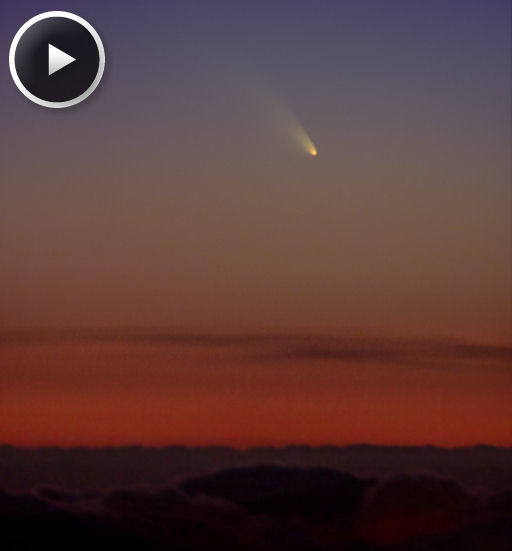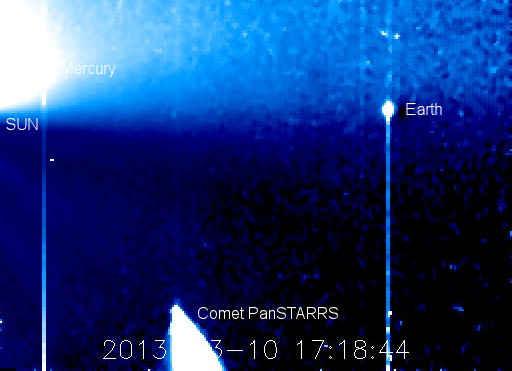Ученые боялись, что Солнце растопит ее ледяное ядро. Однако Панстаррс не пострадала и даже стала еще красивее. Ее пушистый хвост стал пышнее и ярче.
Вот только наблюдать его сложно из-за яркой засветки. Когда комета высоко над горизонтом, ее засвечивает заходящее солнце, а когда темнеет, он становится слишком низкой. Впрочем, это не помешало Полу Оствальду из Сомерс-Пойнт, штат Нью-Джерси, поймать странницу между проводами ЛЭП.

Нью-Джерси, 9 марта 2013 г. © Paul Ostwald | Spaceweather.com
«Комета была низко над горизонтом, когда я сделал этот снимок», — говорит Оствальд. Фото Оствальда подчеркивает проблему, встающую перед наблюдателями. Хотя комета достаточно яркая, где-то между 1-й и 2-й звездными величинами, вечерние сумерки получаются еще ярче.

Канарские острова, 10 марта 2013 г. © Fritz Helmut Hemmerich | Spaceweather.com
Фриц Хельмут Эммерих сделал это фото на Тенерифе, Канарские острова, сразу после захода солнца. «Мы совершили восхождение на высокий вулкан Тейде, чтобы сфотографировать комету, ― говорит Эммерих. ― Как видите, наши труды были вознаграждены».

Канарские острова, 10 марта 2013 г. © Francisco A. Rodriguez | Spaceweather.com
Астрономы советуют смотреть на запад низко над горизонтом в течение 30 минут после захода солнца. Если обнаружить Панстаррс не удастся, лучше сканировать небо через бинокль.

Аризона, 10 марта 2013 г. © Adam Block | Spaceweather.com
По мере удаления кометы от Солнца значительно улучшатся условия наблюдения. Наилучшим периодом ученые называют 12–13 марта, когда Панстаррс будет уже высоко на горизонтом, а Луна только начнет зарождаться.
COMET PAN-STARRS UPDATE: Yesterday, March 10th,
Comet Pan-STARRS(C/2011 L4) made its closest approach to the sun. Inside the orbit of Mercury, the comet was hit by solar rays ten times more intense than we experience on Earth. This sets the stage for a good show as Pan-STARRS, glowing brightly, moves into the night sky later this week. Dr. Fritz Helmut Hemmerich of Tenerife (Canary Islands) caught a hint of things to come on March 10th when he photographed the comet setting just behind the sun:

"We went high on the Teide volcano to photograph the comet [above the roiling clouds]," says Hemmerich. "Each frame in the video is a 4 second exposure taken with a Canon 1100D digital camera set at ISO 400."
Although Comet Pan-STARRS is bright, somewhere between 1st and 2nd magnitude, most observers say they are still having trouble seeing it with the unaided eye in the bright evening twilight. A few seconds exposure with a digital camera, however, reveals it easily. Binoculars help, too.
Visibility will improve in the nights ahead as the comet moves away from the sun. Dates of special interest include March 12th and 13th when Pan-STARRS passes not far from the crescent Moon. The tight conjunction on the 12th provides a splendid opportunity for sunset photographers. Look low and west for a beautiful view.
STEREO-B SEES COMET PAN-STARRS: On March 10th, Comet Pan-STARRS passed by the sun just inside the orbit of Mercury. The close encounter brought it into the field of view of NASA's STEREO-B spacecraft. The sun, Earth, and comet are labeled in this low-resolution beacon image from STEREO-B's Heliospheric Imager:

Comet Pan-STARRS is so bright, it is actually saturating the pixels of the imager's digital camera. The comet's luminosity is mainly due to dust. Earth-based observations show that Pan-STARRS is dustier than an average comet. Comet dust reflects sunlight, so the fan-shaped tail of Pan-STARRS, chock full of it, is especially bright.
Low-resolution beacon images will be followed in a day or so by high-resolution movies. Stay tuned for a great view of Comet Pan-STARRS passing the sun.
http://spaceweather.com/







